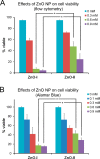Cytotoxicity of ZnO Nanoparticles Can Be Tailored by Modifying Their Surface Structure: A Green Chemistry Approach for Safer Nanomaterials
- PMID: 25068096
- PMCID: PMC4105193
- DOI: 10.1021/sc500140x
Cytotoxicity of ZnO Nanoparticles Can Be Tailored by Modifying Their Surface Structure: A Green Chemistry Approach for Safer Nanomaterials
Abstract
ZnO nanoparticles (NP) are extensively used in numerous nanotechnology applications; however, they also happen to be one of the most toxic nanomaterials. This raises significant environmental and health concerns and calls for the need to develop new synthetic approaches to produce safer ZnO NP, while preserving their attractive optical, electronic, and structural properties. In this work, we demonstrate that the cytotoxicity of ZnO NP can be tailored by modifying their surface-bound chemical groups, while maintaining the core ZnO structure and related properties. Two equally sized (9.26 ± 0.11 nm) ZnO NP samples were synthesized from the same zinc acetate precursor using a forced hydrolysis process, and their surface chemical structures were modified by using different reaction solvents. X-ray diffraction and optical studies showed that the lattice parameters, optical properties, and band gap (3.44 eV) of the two ZnO NP samples were similar. However, FTIR spectroscopy showed significant differences in the surface structures and surface-bound chemical groups. This led to major differences in the zeta potential, hydrodynamic size, photocatalytic rate constant, and more importantly, their cytotoxic effects on Hut-78 cancer cells. The ZnO NP sample with the higher zeta potential and catalytic activity displayed a 1.5-fold stronger cytotoxic effect on cancer cells. These results suggest that by modifying the synthesis parameters/conditions and the surface chemical structures of the nanocrystals, their surface charge density, catalytic activity, and cytotoxicity can be tailored. This provides a green chemistry approach to produce safer ZnO NP.
Keywords: Cancer; Cytotoxicity; Green chemistry; Nanoparticles; Oxides; Semiconductors; Sustainability.
Figures






References
-
- Hoye R. L. Z.; Musselman K. P.; MacManus-Driscoll J. L. Research update: Doping ZnO and TiO2 for solar cells. APL Mater. 2013, 1, 060701.
-
- Hoffmann M. R.; Martin S. T.; Choi W.; Bahnemann D. W. Environmental applications of semiconductor photocatalysis. Chem. Rev. 1995, 95, 69.
-
- Litter M. I. Heterogenious photocatalysis – Transition metal ions in photocatalytic systems. Applied Catalysis B: Environmental 1999, 23, 89.
-
- Legrini O.; Oliveros E.; Braun A. M. Photochemical processes for water treatment. Chem. Rev. 1993, 93, 671.
Grants and funding
LinkOut - more resources
Full Text Sources
Other Literature Sources
Miscellaneous
